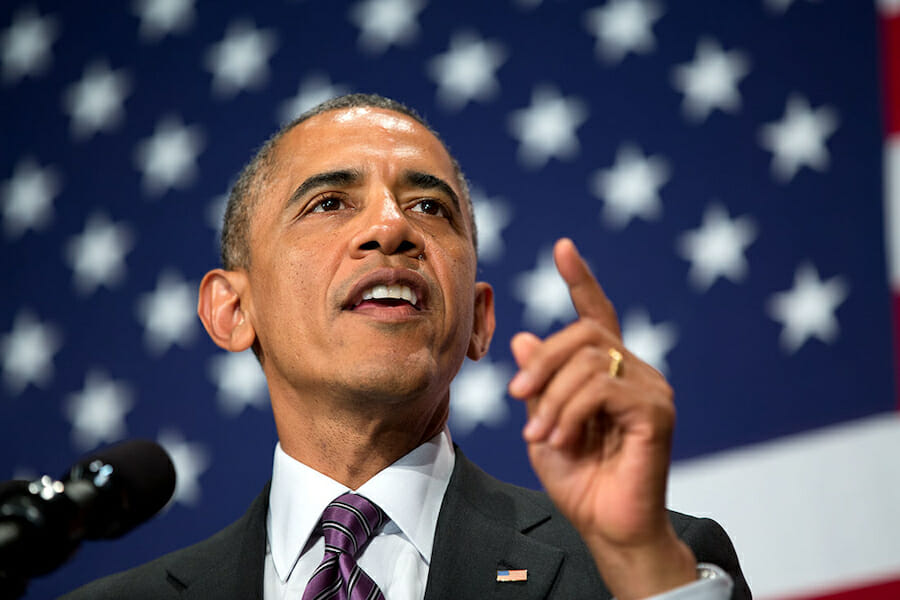
Dragon v. Godzilla: How Far will the U.S. go to Reassure Japan?
US President Barack Obama’s visit to Japan this week came at an opportune time, given the growing friction between Asia’s two largest military powers over disputed territories.
Just last week, Japan began its first military expansion in more than 40 years by breaking ground on a radar station on Yonaguri, a tropical island off Taiwan. Japan intends to send 100-150 soldiers to man its new military lookout station on Yonaguni, which is home to 1,500 people and just 150 km (93 miles) from the disputed Japanese-held Senkaku islands claimed by both China and Taiwan. Japanese Defence Minister Itsunori Onodera, who attended a ceremony on Yonaguni island to mark the start of construction, suggested the military presence could be enlarged to other islands in the seas southwest of Japan’s main islands. Perhaps in retaliation, the Shanghai Maritime Court seized a Japanese vessel for failing to respond to a compensation order stemming from a wartime contractual dispute. The action was taken just prior to Obama’s visit and appears to be the first time that an asset of a Japanese company has been confiscated in a lawsuit concerning wartime compensation.
Faced with the dilemma of choosing sides during his visit to Tokyo, President Obama reiterated Washington’s backing of the US-Japan security treaty, stating “Article five covers all territories under Japan’s administration including (the) Senkaku islands,” referring to the archipelago which Beijing calls the Diaoyus and the Taiwanese refer to as the Diaoyutai. Clearly not wishing to be drawn into a military conflict, Obama called for a peaceful resolution to the territorial dispute over the islands, adding “We do not believe that they should be subject to change unilaterally, and what is a consistent part of the alliance is that the treaty covers all territories administered by Japan.”
Sovereignty over the Senkaku/Diaoyu island chain has been disputed for decades, though Tokyo and Beijing generally held to a tacit agreement by which Japan would avoid any landings or new construction, and China would delay its assertion of its claim.
In 2012, however, this precious balance was overturned when the hardline nationalist governor of Tokyo, Shintaro Ishihara, started raising funds for the purchase of three of the five islands, with the intention to construct a port. At this point, the national government claims it felt obliged to step in and purchase the islands from its private Japanese owners.
While Tokyo claims the purchase was necessary in order to keep the peace, Beijing was infuriated over the nationalization of the island chain. The dispute is not merely over a pile of rocks – the East China Sea is believed to contain significant quantities of hydrocarbon resources, which both China and Japan covet in their need to diversify their energy supplies.
Since the balance was tipped in Tokyo’s favor, Chinese state media have regularly chastised Japan over the territorial dispute and accused it of nascent militarism and denial of wartime atrocities. China has also applied other pressures on Japan, using threats of economic retaliation, refusing to attend conferences held in Tokyo, or by stirring up anti-Japanese sentiment at home. This month’s visit by Yoshitaka Shindo, Japan’s internal affairs minister, to the Yasukuni Shrine, where Japanese convicted war criminals are buried, certainly didn’t help the situation and was loudly condemned by Beijing. The US has also received an earful of diplomatic posturing and rhetoric. During Hagel’s visit earlier this month to Beijing, China’s defense minister, General Chang Wanquan told the Vietnam War veteran that sovereignty over the islands in the East China Sea was non-negotiable and that it would “make no compromise.”
Certainly, strong rhetoric has emanated from both Beijing and Tokyo in recent years, but the dispute has not been limited to vocal appeasement of the nationalistic fringe. The 2010 ramming of Japanese Coast Guard cutters by a Chinese fishing boat and the subsequent arrest of the Chinese captain by the Japanese was a significant event – halting what had been a promising joint development of the potentially gas-rich Chunxiao/Shirakaba field. Ships and aircraft from both countries now regularly patrol the area and have often come close to sparking conflict. In a tense incident early last year, Japan accused a Chinese frigate of locking its weapon-targeting radar on one of Tokyo’s naval vessels.
Adding to the tension was Beijing’s declaration in November of an air defense identification zone – covering a large swathe of the East China Sea and the disputed islands. The friction between the two countries is so great now, that Japan felt compelled to scramble its combat planes against Chinese aircraft 415 times during the year, up 36 percent from a year earlier and the highest number recorded to date. With scrambles averaging at least one per day, a single miscalculation or unwillingness to stand down could easily trigger limited warfare.
While President Obama has made Washington’s support for Tokyo abundantly clear this week, not all Japanese are convinced of unwavering support from the United States. Japan does host the US military’s forward position in the Pacific, consisting of a port for the Seventh Fleet and nearly 50,000 troops stationed on key strategic bases. But Washington has shown recent reticence in involving itself militarily in Syria and Ukraine, and some fear that under certain circumstances, the US may choose not to fight Japan’s battles.
In the event of any hypothetical escalation, and the refusal of Washington to get involved, how would Japan’s military stack up against a growing Chinese military? Looking at sheer numbers, China would seem to come out on top. Beijing has continued to grow its defense budget in double-digits, even as its economy slows to 7.5 percent GDP growth. Indeed, China’s spending has been so significant and consistent, that its military now clearly outnumbers Japan’s in terms of manpower, ships, aircraft, and defense spending, according to the International Institute for Strategic Studies’ Military Balance 2014 report, published in February. The report revealed that China’s defense budget was $112.2 billion last year, compared to $51 billion for Japan. China had approximately 2.3 million active-duty troops last year compared with Japan’s 247,150 and also enjoyed huge leads in combat aircraft at 2,525 to 630, main battle tanks at 6,840 to 777, and tactical submarines at 66 to 18.
Yet in looking at China, we often are so dazzled by the quantity that we overlook quality. According to the same report, China’s military “remains qualitatively inferior, in some respects, to more technologically advanced armed forces in the region — such as South Korea and Japan — and it lags far behind the US.” The report points to such shortfalls as a lack of combat experience, questions about training and morale, and weaknesses in command and control, anti-submarine warfare and other areas. So in picking small fights with Japan, Beijing may be less interested in military escalation than in flexing its new muscles to placate the growing arrogance of its nationalist fringe.
The top command of China’s military is no doubt fully cognizant of its weaknesses and Japan’s advantages in technology, training, and equipment will only go so far in provoking the Japanese. Beijing understands the need to coordinate its haphazard international security apparatus, as evidenced by the first meeting of a new national security commission last week, which hopes to increase coordination among the various wings of China’s security bureaucracy, split now among the police, military, intelligence, and diplomatic services. Beijing is also well aware of the need to clean up its corrupt military and deal with those high-ranking officers currently under investigation. Beijing’s strategy may well be to patiently chip away at its enemies while building its capacity – they know an armed conflict now could seriously stall their hopes of growing into a major regional power.
The overwhelming advantages in technology, training, and equipment held by Japan’s military mean that Beijing has limits to how much it can provoke Tokyo. These limits, however, are not clear and are likely to be tested over the coming months, despite assurances from China’s defense minister, General Chang Wanquan. In his meeting with Hagel, Chang suggested China would not take preemptive action: “We will not take the initiative to stir up troubles.” Yet, given China’s inherent weaknesses in command and control, and a loose definition of ‘initiative,’ it is not inconceivable that one minor Chinese or Japanese naval official crosses that line of acceptable engagement, perhaps in an accidental collision, and triggers a limited armed skirmish in the East China Sea. Whether or not Washington backs its Japanese ally and sends in its military will depend on the extent of the skirmish, but an altercation with a high-tech Japanese military will not be as easy as China’s hard-line nationalists seem to think.

